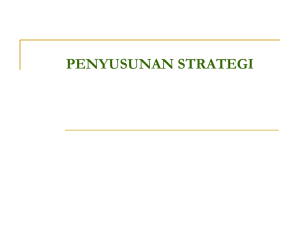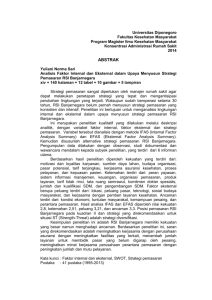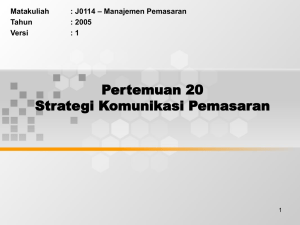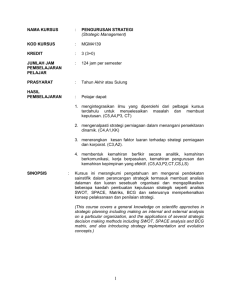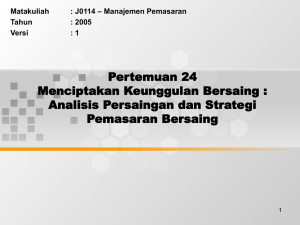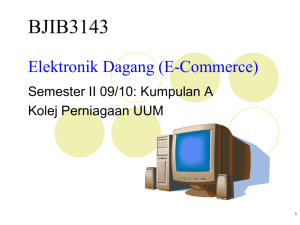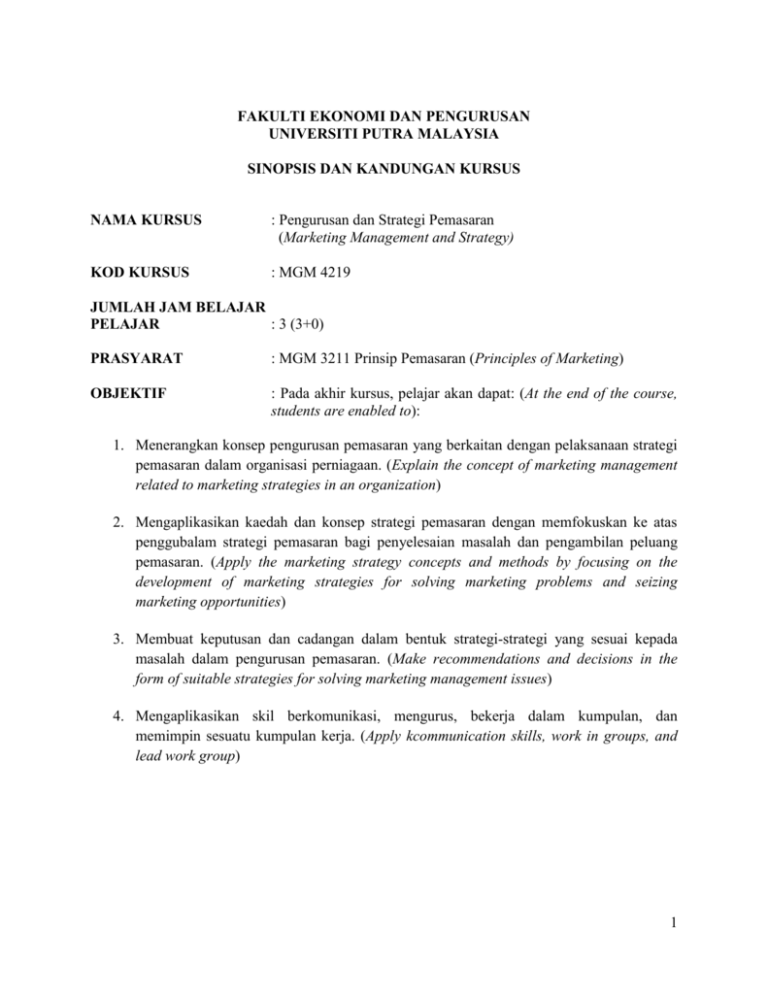
FAKULTI EKONOMI DAN PENGURUSAN
UNIVERSITI PUTRA MALAYSIA
SINOPSIS DAN KANDUNGAN KURSUS
NAMA KURSUS
: Pengurusan dan Strategi Pemasaran
(Marketing Management and Strategy)
KOD KURSUS
: MGM 4219
JUMLAH JAM BELAJAR
PELAJAR
: 3 (3+0)
PRASYARAT
: MGM 3211 Prinsip Pemasaran (Principles of Marketing)
OBJEKTIF
: Pada akhir kursus, pelajar akan dapat: (At the end of the course,
students are enabled to):
1. Menerangkan konsep pengurusan pemasaran yang berkaitan dengan pelaksanaan strategi
pemasaran dalam organisasi perniagaan. (Explain the concept of marketing management
related to marketing strategies in an organization)
2. Mengaplikasikan kaedah dan konsep strategi pemasaran dengan memfokuskan ke atas
penggubalam strategi pemasaran bagi penyelesaian masalah dan pengambilan peluang
pemasaran. (Apply the marketing strategy concepts and methods by focusing on the
development of marketing strategies for solving marketing problems and seizing
marketing opportunities)
3. Membuat keputusan dan cadangan dalam bentuk strategi-strategi yang sesuai kepada
masalah dalam pengurusan pemasaran. (Make recommendations and decisions in the
form of suitable strategies for solving marketing management issues)
4. Mengaplikasikan skil berkomunikasi, mengurus, bekerja dalam kumpulan, dan
memimpin sesuatu kumpulan kerja. (Apply kcommunication skills, work in groups, and
lead work group)
1
SINOPSIS :
Panduan yang praktikal untuk membuat keputusan pemasaran dan pembangunan strategi
pemasaran dengan mengambilkira pendekatan antara disiplin/bidang; liputan adalah global,
topical dan tertumpu kepada tajuk-tajuk yang meliputi analisis strategic, penggubalam,
pelaksanaan dan kawalan strategi dan strategi-strategi pemasaran. (A practical guide to
marketing decision making and the development of marketing strategy, which takes an
interdisciplinary approach, with global, topical and focused coverage. Topics include strategic
analysis, strategy formulation and implementation, and marketing and marketing control
strategies)
COURSE ASSESSMENT :
Course work: Assignments:
Case study
Article review
Marketing Plan
Final Exam:
20% (PENILAIAN BERTERUSAN)
20% (PENILAIAN 1)
20% (PENILAIAN 2)
40%
TEXT :
Mullins, J.W. and Walker, O.C. (2013). Marketing Management: A Strategic DecisionMaking Approach, 8th edition, Singapore:McGraw-Hill.
OTHER REFERENCES:
Ferrel, O.C. and Michael, D.H. (2008). Marketing Strategy, 4th edition, Mason
Ohio:Thomson South-Western.
Marshall, G.W. and Johnston, M.W. (2010). Marketing Management, New York:
McGraw-Hill Irwin.
Modul PJJ MGM 4219/4291 Pengurusan dan Strategi Pemasaran
2
APPENDICES
CASE ANALYSIS
When evaluating cases, students should address the following areas:
1. Background of the situation, including organizational factors and the external
environment
2. The various concerns, issues, and problems evident in the situation
3. The main area of concern (main problem)
4. Alternative courses of action
5. Evaluation of alternatives based upon the criteria selected for this purpose
6. Selection of a course of action
7. Plans for implementing the course of action
8. Identification of possible follow-up problems
As students prepare cases for class discussion and for written assignments, they should consider
the following;
9. Carefully evaluate all information presented in the case
10. List all possible problems and concerns, being sure to look at causes of the problem area,
not symptoms
11. Use textbook material, current articles and other resources (library materials, interviews,
field observations) to research the situation, problem, and alternatives
12. Be creative in developing alternative courses of action
13. Assess each alternative based on the information in the case and the criteria established
14. Be ready to defend the selected course of action.
For students to fully benefit from a case analysis assignment, they must PREPARE and
PARTICIPATE in the discussion.
3
How To Write a Case Study Analysis
By Karen Schweitzer, About.com Guide
When writing a case study analysis, you must first have a good understanding of the case study.
Before you begin the steps below, read the case carefully, taking notes all the while. It may be
necessary to read the case several times to fully grasp the issues facing the company or industry.
Once you are comfortable with the information, begin the step-by-step instructions offered below
to write a case study analysis.
Time Required: Varies
Here's How:
1. Investigate and Analyze the Company’s History and Growth. A company’s past can
greatly affect the present and future state of the organization. To begin your case study
analysis, investigate the company’s founding, critical incidents, structure, and growth.
2. Identify Strengths and Weaknesses Within the Company. Using the information you
gathered in step one, continue your case study analysis by examining and making a list of
the value creation functions of the company. For example, the company may be weak in
product development, but strong in marketing.
3. Gather Information on the External Environment. The third step in a case study
analysis involves identifying opportunities and threats within the company’s external
environment. Special items to note include competition within the industry, bargaining
powers, and the threat of substitute products.
4. Analyze Your Findings. Using the information in steps two and three, you will need to
create an evaluation for this portion of your case study analysis. Compare the strengths
and weaknesses within the company to the external threats and opportunities. Determine
if the company is in a strong competitive position and decide if it can continue at its
current pace successfully.
5. Identify Corporate Level Strategy. To identify a company’s corporate level strategy for
your case study analysis, you will need to identify and evaluate the company’s mission,
goals, and corporate strategy. Analyze the company’s line of business and its subsidiaries
and acquisitions. You will also want to debate the pros and cons of the company strategy.
6. Identify Business Level Strategy. Thus far, your case study analysis has identified the
company’s corporate level strategy. To perform a complete analysis, you will need to
identify the company’s business level strategy. (Note: if it is a single business, the
corporate strategy and the business level strategy will be the same.) For this part of the
case study analysis, you should identify and analyze each company’s competitive
strategy, marketing strategy, costs, and general focus.
7. Analyze Implementations. This portion of the case study analysis requires that you
identify and analyze the structure and control systems that the company is using to
4
implement its business strategies. Evaluate organizational change, levels of hierarchy,
employee rewards, conflicts, and other issues that are important to the company you are
analyzing.
8. Make Recommendations. The final part of your case study analysis should include your
recommendations for the company. Every recommendation you make should be based on
and supported by the context of your case study analysis.
Tips:
1. Know the case backwards and forwards before you begin your case study analysis.
2. Give yourself enough time to write the case study analysis. You don't want to rush
through it.
3. Be honest in your evaluations. Don't let personal issues and opinions cloud your
judgement.
4. Be analytical, not descriptive.
5. Proofread your work!
This About.com page has been optimized for print. To view this page in its original form, please
visit: http://businessmajors.about.com/od/casestudies/ht/HowToCaseStudy.htm
©2013 About.com, Inc. All rights reserved.
5
How to Write a Critical Article Review
(Summarize a Research Article)
Overview
When writing a critical review of an article, you will need to summarize, evaluate, and offer
critical comment on the ideas and information that the author(s) presents in the article.
Research / scientific articles are highly structured to make information easy to find. The research
article usually has the following sections: Title Page, Abstract, Introduction, Method, Results,
Discussion, References, and Tables / Figures.
Your goal should be to read and understand the article, analyze the findings or arguments, and
evaluate and comment on the article.
Reading the Article
Allow enough time to understand it.
Read the article without taking notes to gain an overall idea of its main idea.
Identify:
-- the research question (usually stated in the Abstract and Introduction)
-- the hypothesis(es) (usually in the Introduction)
-- the test of the hypothesis (in the Methods)
-- the findings (in the Results, including tables and figures)
-- how the findings were interpreted (in the Discussion)
Read the article again analytically and make notes of main ideas and main topic.
Highlight important ideas and make brief notes.
Read the article in depth again.
Ask yourself these questions:
-- What is interesting about this information?
6
-- How does the author(s) support the hypothesis?
-- What is the main aim of the article?
-- Is the article timely?
-- Is the argument / thesis convincing? Is the evidence valid?
-- How does the study design address the thesis?
-- What are the controls for each experiment?
-- Is the methodology appropriate? Any weaknesses?
-- Are the results convincing? Is it comprehensive and through?
-- What questions remain unanswered? Anything omitted?
-- Are the findings presented and described clearly and fully?
-- Could the data be interpreted in another way?
-- How does the article contribute to the field? Does it make an original contribution to the field?
-- How does the article relate to the course?
Writing the Article Summary
Introduction
-- Give the title of the article and name of the author(s) and provide a full citation of the article.
Identify the writer by profession or importance.
-- Identify the purpose of the article.
-- Tell what the research question is and explain why it is interesting and important. Give your
overall impression.
-- It is important that the introductory paragraph include a thesis statement which identifies the
main points you will be discussing in the body (analysis) of the review.
Body (Analysis)
-- Briefly describe the methods, design of the study, how many subjects were involved, what
they did, the variables, what was measured, and where the research was conducted.
7
-- Describe the results / what was found.
-- Write an analytical summary of the main findings, arguments, or conclusions of the article /
study.
-- Discuss the strengths and usefulness of the article / study.
-- Discuss the weaknesses, limitations, or problems of the article / study.
-- Discuss what you learned from the article and if you recommend it to other students.
-- Support your analysis with quotations and/or specific examples throughout.
Conclusion
-- Summarize the previous discussion.
-- Make a final judgement on the value of the article.
-- State what you learned from the article.
-- Comment on the future or implications of the research.
Source: University of Maine System Copyright 2007 UMS. All rights reserved.
Last revised: Wednesday, January 17, 2007
8
CRITICAL ARTICLE REVIEW
1. Read the article several times. Begin by looking quickly at the opening statements,
headings and opening sentences of each paragraph and the conclusion. Then go back to
the beginning and read the article in its entirety. Reading the article a third time with a
highlighter or pen in hand allows for making notes or highlighting important sections.
2. Create a summary outline. This is an outline of the main points made in the article and
the supporting research or arguments. It is strictly a restatement of the main points of the
article and does not include your opinions. Review the summary outline to eliminate
unnecessary items. Erase or cross out the less important arguments or supplemental
information.
3. Write an outline of your opinions. Review each item in the summary outline to
determine whether the author was accurate and clear. Write down in outline form all
instances of effective writing, new contributions to the field, as well as areas of the article
that need improvement.
o
Create a list of strengths and weaknesses. The strength of the article may be that it
presents a clear summation of a particular issue. Its weakness may be that it does
not offer any new information or solutions.
o
Use specific examples and references. For example, the article might have
incorrectly reported the facts of a popular study. Jot down this observation in your
outline and look up the facts of the study to confirm your observation.
4. Start your review by referring to the title of the article in the first paragraph.
Include the name of the author.
5. Summarize the article. Express the main points and arguments of the article in your
own words, referring to your summary outline for assistance. This may be done in several
paragraphs, although the length will depend on requirements established by your
instructor or publisher.
o
Review the summary you have written. Read over your summary several times to
ensure that your words are an accurate description of the author's article.
6. Write the opinion portion of your article review. Use your outline of opinions to write
several paragraphs explaining how well the author addressed the topic. Express your
opinion about whether the article was a clear, thorough and useful explanation of the
subject.
9
o
Use a topic sentence and supportive arguments for each opinion. For example,
you might address a particular article strength in the first sentence of the opinion
section, followed by several sentences elaborating on the significance of the point.
7. Conclude the article review. In a paragraph, summarize the main points of the article, as
well as your opinions about its significance, accuracy and clarity. If relevant, also
comment on implications for further research or discussion in the field.
10
Writing a journal article review
You may be asked to write a journal article review. Although this may be an unfamiliar exercise,
it is not as complex a task as writing an essay requiring a lot of library research, and not the same
as a review in The Canberra Times which is written for the general reader. Your journal article
review is written for a reader (eg, your supervisor, lecturer or tutor) who is knowledgeable in the
discipline and is interested not just in the coverage and content of the article being reviewed, but
also in your critical assessment of the ideas and argument that are being presented by the author.
Your review might therefore be guided by the following questions:
Objectives What does the article set out to do?
Theory Is there an explicit theoretical framework? If not, are there important
theoretical assumptions?
Concepts What are the central concepts? Are they clearly defined?
Argument What is the central argument? Are there specific hypotheses?
Method What methods are employed to test these?
Evidence Is evidence provided? How adequate is it?
Values Are value positions clear or are they implicit?
Literature How does the work fit into the wider literature?
Contribution How well does the work advance our knowledge of the subject?
Style How clear is the author’s language/style/expression?
Conclusion A brief overall assessment.
So how can you begin to meet these demands?
Step 1: Get to know the article you are reviewing:
Look at the title, the table of contents, the abstract and the introduction. These should
give you some idea of the central focus and the coverage of the article and the author's
reasons for writing the article. Skim quickly through the whole article, running your eye
over opening sentences of paragraphs and glancing at any tables, illustrations or other
graphic materials. Read more closely the first section, which should tell you the main
issues to be discussed and indicate the theoretical or conceptual framework within which
the author proposes to work. Read closely the final section, which should cover the
author's conclusions and summarise the main reasons why these conclusions have been
reached. Now that you are familiar with the text, read the whole text thoroughly to
develop a basis on which to critically review it.
Step 2: Decide which aspects of the article you wish to discuss in detail in your review:
the theoretical approach? the content or case studies? the selection and interpretation of
evidence? the range of coverage? the style of presentation? Usually you will discuss the
main issues which the author has specifically examined. Sometimes you may choose a
particular issue because it has importance for you and the course you are studying, even if
it is not the main issue for the author.
11
Step 3: Now, on the basis of your overall knowledge of the article and your decision
about which issues you will discuss, read in closer detail the sections which are relevant
to these issues. Make notes of the main points and key quotations. If necessary, read other
articles or books which are relevant to your topic, possibly to provide supporting
evidence or alternative theoretical models or interpretations of data. You may also want
to glance at other reviews of the article in recent academic journals in order to get a feel
for the way the article has been received within the discipline. However only use these
reviews to support your own evaluation; don't merely copy or imitate them.
Now you are ready to start drafting and writing your review.
The structure of your review should include:
• an initial identification of the article (author, title of article, title of journal, year of
publication, and other details that seem important, eg, it is originally a French edition,
etc), and an indication of the major aspects of the article you will be discussing.
• a brief summary of the range, contents and argument of the article. Occasionally you
may summarise section by section, but in a short review (1,000-1,500 words) you usually
pick up the main themes only. This section should not normally take up more than a third
of the total review.
• a critical discussion of 2-3 key issues raised in the article. This section is the core of
your review. You need to make clear the author's own argument before you criticise and
evaluate it. Also you must support your criticisms with evidence from the text or from
other writings. You may also want to indicate gaps in the author's treatment of a topic;
but it is seldom useful to criticise a writer for not doing something they never
intended to do.
• a final evaluation of the overall contribution that the article has made to your
understanding of the topic (and maybe its importance to the development of knowledge
in this particular area or discipline, setting it in the context of other writings in the field).
Checklist for your final draft:
• Have you identified the article clearly, right at the start?
• Is the author's argument clearly and objectively summarised so that your reader can
recognise the theoretical approach and the range of material covered? (About a third of a
short review.)
• Are the 2-3 key issues raised in this article clearly identified and discussed? (About 5060% of the review.)
• Have you given reasons for your criticism and your approval of the article?
• Is there a final evaluation of the article's importance, based on your earlier discussion?
12



